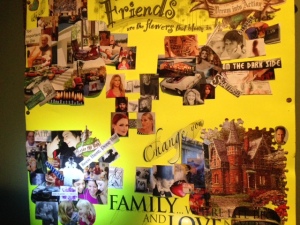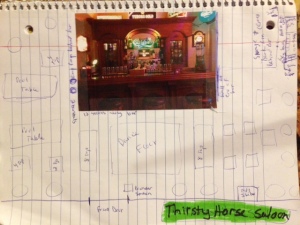If you’ve visited Jenny Crusie’s ArghInk recently, you’ve seen the most recent collage she’s been creating for a new writing project. If you haven’t seen it, you really should go take a look. It involves carpentry, painting, pictures. It’s a 3-dimensional peek into the story world she and collaborators are creating.
Collage was one of the story discovery tools we discussed during our McDaniel coursework. This is a picture of the collage I did for My Girls during our discovery module. Note that it’s in 2-D. It isn’t fabulous or beautiful or awe-inspiring. It involves simple cut-out pictures and phrases arranged in groupings. But that collage hangs in my office to this day, and even though I’ve revised the story and not the collage, it provides a touchstone when I need to recapture a particular mood or element of the story.
I am one of the least visually artistic people I know. As proof of that, I point you again to the picture of my (not) fancy collage. My lack of talent in the visual arts kept me from collaging for story discovery for years. But once I tried it, I learned the most important thing about a visual depiction of your story: it’s not about the aesthetic, it’s about making your brain come at the story from a different perspective. For me, that new perspective came from those groupings. Not the ‘what’ of them, but the ‘why’. Figuring out why I’d put elements where I had helped me clarify character relationships and arcs. Trying to decipher one particular choice I’d made for the group of pictures in the lower right-hand corner inspired a really crappy poem from the POV of one of the antagonists, which in turn made me realize one of the minor characters had actually died before the beginning of the book’s timeline.
A few weeks ago, I created an even less beautiful (no, I will not call it ugly) visual representation of one of the places in my book to help me block out scene revisions. It’s a picture (using the term loosely) of The Thirsty Horse Saloon, which is owned by one of the main characters and is where both the first and last scenes take place. The image of that place has lived inside my head for years, but ‘drawing’ it made me consider the size and proportion of the place. Referencing the picture while I revised those two scenes, which mirror each other in many ways, forced me to think about how the characters would have to move through that space.
While I have not included a detailed description in the story and readers’ images of it will be their own, I have included little details in each scene to make the space seem more real. For example, I had to decide whether there are windows in the Thirsty Horse (there are not), and how that would affect the lighting at night (first scene) and the in the daytime (last scene) differently. I even drew a representation of the neon sign out front, denoted by the green highlighted box (there is no end to the fanciness, I tell you!). Because the actual (in my head) sign features a neon outline of a horse with legs that ‘run’ (which would explain why the horse is thirsty), that box is obviously just a mental placeholder for my brain.
I envy the artistically talented sketch artists/painters/sculptors/collagers who make pieces of art as part of the discovery and rediscovery phases of their books. I will never be one of them. But I don’t need fancy artwork for my office (I have a dragon!),I just need as many tools as possible to help my stories come alive and then help me transfer them to the page. Do you collage your stories? Build cool structures for them? What tools have you used to ‘visualize’ story?



I’ve done collage twice voluntarily, not counting the time we were forced into it 🙂 for McD, so that would be three times altogether. The first time, I was stuck just after I was halfway through the book—I had the beginning and ending, and the problems/conflicts of the middle, but I couldn’t see how to tie it up. I took a collage class, willing to try anything. And at the end of class, I had a neat collage in the shape of a wave, with a complex beginning and ending, a thinner middle to about halfway through, and then a big blank spot just after halfway. Yeah. Big help.
And then another time I had a dramatic scene with a lot of gunslinging in a big room with a lot of furniture and way too many people. And, like you with the notebook page, I drew a little, cut out a few pictures, and figured out where people could start out and where they could move to so they wouldn’t get hurt when the bullets started flying. That really worked.
The collage we did for McD didn’t do much for me. I think the electronic nature of it added too cumbersome a layer for me to cope with, given my limitations with the whole concept of collaging.
However, anything that works, I’m all in favor of. I’m not saying I’d never do collage again. Just that it doesn’t seem to trigger much for me, or bring me back to where I need to go. Although my current WIP has been in hiatus long enough now that if I’d done a collage, it would probably help trigger some memories. Oh, well.
I didn’t do an electronic version of the collage for McD. I used good old-fashioned poster board and physically cut and tacked (and rearranged and then pasted) pictures and phrases. One of the reasons I did it that way was that doing tactile things engages the story part of my brain. Cooking and baking that don’t require too much thought or concentration are other ‘tactile’ things that let my brain run through story problems and scenarios (although pay attention if measurements matter. I recently made an apple pie with brandy as one of the flavorings, and used the wrong measuring cup, effectively tripling the amount of brandy in the filling. Fine for me, I like brandy :-). Not so fine for those who don’t.).
You’re right, what I did with drawing Maddie’s bar for My Girls sounds a lot like the work you did for your barroom scene. What is it with us and bars? Birds of a feather…
You know, I think this triggered a lightbulb moment for me, Kay. The collage helps the Girls say things when they can’t put it into words, and the other side of the brain is having trouble understanding the connections that the Girls find so obvious. But if even the Girls don’t know, collaging is a lot more work.
I had to collage the first scene in my book for class because nobody in my head really knew where it was going anymore. I do better discovery with words, I think.
What it did do for me was make me realize that I didn’t have a clear perception of the space involved. I enjoyed putting up a pool, and making sure Hadiz was on the diving board, and my super sisters were on the other side, and the rest of the monsters and characters. I also did a map of the space like Nancy did, and it helped tremendously.
(-: I wish mine were works of art, too. I look at Jenny’s latest, and I can’t help but think that her grandkids would adore that dollhouse (-:. Amazing work.
LOL! Well, I don’t know about you, but I’ve spent a lot of quality time in bars, so many of them have happy memories for me. Your pie? I did that once with cake. Just sayin’.
(-: See above, but my biggest visual cues are picture files — I use pinterest, but my “pin it” tool has fallen down to the bottom of my bookmarks, and there are too many. It’s just more handy to use a picture file, especially when I can’t get internet. These may include characters, settings, reminder to visit a blog or history website, etc.
The problem is, I have too much stuff for my memory banks now. I need to move some things off into a dedicated hard drive (for back-up) and USB stick (for everyday use).
This just certifies that everybody has their own path. I’d lose everything if I had to sort out stuff for external hard drive, USB stick, etc. Ack! Maybe one of these days I’ll get more comfortable with collaging, though.
Pingback: Michaeline: Story Bites for When You Just Can’t – Eight Ladies Writing